Haryana State Board HBSE 10th Class Science Important Questions Chapter 8 How do Organisms Reproduce Important Questions and Answers.
Haryana Board 10th Class Science Important Questions Chapter 8 How do Organisms Reproduce?
Question 1.
Explain reproduction. Why is it vital? OR Reproduction is not necessary for maintaining the life of an Individual then why do organisms reproduce?
Answer:
Reproduction:
1. The production of new organisms from the existing organisms of same species is known as reproduction.
2. Every organism remains alive for a limited time. In other words, one that takes birth has to die at some point of time.
3. Considering this fact, if an organism does not reproduce, it is quite likely that one day its species will become extinct. Not only this, even if one species vanishes, it disturbs the entire environmental cycle.
4. Hence, even though, the organism does not need to undergo reproduction for maintaining his own life, it reproduces so that it may continue the existence of its species. And this is the reason why reproduction is vital for the survival of the species.
![]()
Question 2.
Organisms of the same species look similar. What is the role of DNA copying in this? OR Discuss the meaning and need of DNA copying.
Answer:
1. All organisms of a particular species look similar. For example, dogs look like dogs and a human looks like another. This happens because the designs of their bodies are similar.
2. Naturally, if the body designs are to be similar, the blueprints for these designs should be similar. Thus, similar blue prints lead to formation of similar bodies.
Producing copies of DNA:
1. The first and foremost task of the reproduction process is to make ‘copies of blueprints of body design’. This is done by creating copies of DNk
2. The nucleus of cells contains chromosomes and chromosomes contain genetic material called DNA. DNA contains information about protein synthesis.
3. If the information is changed, there will be a change in protein synthesis, which will eventually change the body design. In such case, one organism may look quite different than the other and we would not be able to classify an organism into a specific species. Therefore, the most basic work in the process of reproduction is to create a DNA copy. Cells undergo certain chemical reactions to build the copies of their DNA.
Question 3.
Why only DNA copying is not sufficient for creating similar organisms? What else should be done? OR ‘Although DNA copying is the basic activity for creating similar organisms, It does not ensure survival’. Explain.
Answer:
1. A cell that undergoes reproduction creates two copies of DNA. Then, both these copies need to be separated from each other.
2. Production of a new cell takes place through the process called ‘cell division’.
3. It is not possible to keep one copy of DNA inside the cell and simply push out the second copy. The second copy of DNA would not survive this way.
4. In order to make the DNA survive, a complete ‘cell apparatus’ or simply a complete cell will have to be produced. The new cell will safely contain and preserve the second copy of the DNA.
![]()
Question 4.
How does DNA copying leads to variation In organisms? Is this variation harmful?
Answer:
1. During cell division, a cell divides to give rise to two cells. Although, the two cells will be similar but will not be exactly identical. It is quite obvious that the process of copying the DNA will have some variations. Hence, the generated DNA copies will be similar, but may not be identical to the original.
2. At times, some variations in DNA copying are so drastic that the new DNA copy cannot work with the cellular apparatus it inherits. Such a new born cell will eventually die.
3. In conclusion, the cells that survive after the cell division are (1) similar to each other as well as (2) different i.e. show variation. This inbuilt tendency for variation during reproduction is the basis for evolution which is useful for the organism to adapt to ever changing environment.
Question 5.
Is a reproduced cell identical? What happens If this ¡s not the case?
Answer:
1. Whether the new cell formed will be identical or not depends on how accurately the sequence of information has been copied.
2. Copy error is a rare event, still at times it may take place.
3. If the newly produced cell is not identical, there may occur changes in its characteristics.
4. If these changes are not compatible with the existing cellular system, the cell may die.
Question 6.
What is meant by creation of additional cellular apparatus?
Answer:
1. When a cell undergoes division, it must make copy of the cell DNA. However, simply making a copy of DNA is not sufficient during cell division, since the DNA molecule itself cannot survive and carry out all the functions of a cell.
2. The DNA will require all the other parts of the cell i.e. the cellular organelles such as nucleus. mitochondria, Golgi body, etc. so that the DNA can survive in the newly formed whole cell. This would be a fully functional cell and hence called a cellular apparatus or simply a cell.
3. Creating an addItional cellular apparatus means to produce a copy of all the parts of the cell (other than DNA).
![]()
Question 7.
What is a clone? Why do offspring formed by asexual reproduction exhibit remarkable similarity?
Answer:
1. A clone is an identical genetic copy of either a piece of DNA, or a cell or a whole organism. Many organisms produce clones through asexual reproduction.
2. A clone genetically identical to the parent i.e. it possesses the exact copy of DNA of its parent and hence it shows remarkable similarity to the parent as well as to one another.
Question 8.
What is niche? Explain.
Answer:
Niche:
1. A niche is the role and position a species plays in the environment, how the species meets its needs for food and shelter, how it survives and how it reproduces.
2. Different species of organisms have different niches.
3. For example, the way a lion gathers Its food or shelter or reproduces are quite different from that of a crocodile i.e. the niches of two organisms vary.
Important aspects with respect to niches are —
- Variation is seen among niches of various species.
- The niches can change because the causes for their changes are not under the control of the organisms. Changes could be due to change in the temperature of the earth, which can go up or down, variation in water level, meteor hits, etc.
- Minor variations in the body designs with respect to a changing niche increases the chances of survival of the organism.
![]()
Question 9.
Give an example where in variation in species becomes a boon for surviving in the changed niche.
Answer:
1. Suppose a population of reproducing organism was suited to a particular niche.
2. A drastic change occurs in the niche, which can wipe out the entire population because the population cannot withstand such a drastic change.
3. Assume a population of bacteria living in temperate waters. If the temperature of water increases to global warming, most of these bacteria would die. But if in some individuals of this population, some variations exist which can allow them to with stand such changes. then these individuals will survive and the entire population will not wipe off.
4. Thus, we can say variation in the species can save the existence of that species in this world. Thus, variation is useful for the survival of species.
Question 10.
What is asexual reproduction? State its types.
Answer:
Asexual reproduction :
The method of producing a new plant (or animal) without the act of fertilization of gametes is called asexual reproduction.
Types:
- Fission
- Fragmentation
- Regeneration
- Budding
- Vegetative propagation and
- Spore formation.
Question 11.
Explain the fission method of asexual reproduction.
Answer:
Fission :
1. Fission is the simplest method of asexual reproduction in unicellular organisms such as bacteria and protozoa.
2. In fission process, a unicellular organism divides to form two or more new organisms.
Types : (A) Binary fission and (B) Multiple fission
(A) Binary fission:
- Many bacteria and protozoa simply split into two equal halves during cell division.
- In binary fission, the nucleus lengthens and then divides into two parts.
- After that the cytoplasm divides into two parts. This results in two daughter cells.
![]()
(1) Binary fission in amoeba:
Amoeba has no definite shape. Hence, binary fission can take place from any place (or say plane) of the amoeba cell resulting into two daughter cells.

(2) Binary fission in leishmania:
- Some unicellular organisms like leishmania shows somewhat more organized binary fission of their bodies.
- Leishmania has a whip-like i.e. longitudinal structure at one end of the cell. So in leishmania, binary fission takes place in a definite orientation (plane) unlike amoeba.
- Leishmania causes an infectious disease called kala-azar or say black fever.
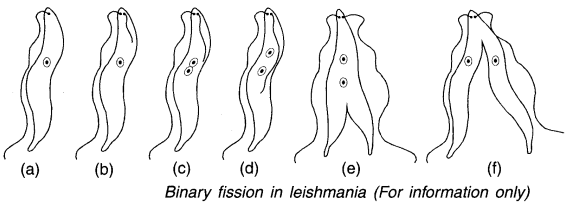
(B) Multiple fission:
1. In multiple fission, the parent organism divides to form many new organisms at the same time.
2. Malarial parasite, plasmodium, divides into many daughter cells simultaneously by multiple fission.

Question 12.
How is binary fission in amoeba different than that in lelshmania?
Answer:
1. In amoeba, binary fission can happen at any place or say plane of the cell.
2. Leishmania has a whip-like i.e. longitudinal structure at one end of the cell. So, in leishmania, binary fission takes place in a definite orientation (plane).
Question 13.
Differentiate between binary fission and multiple fission.
Answer:
| Binary fission | Multiple fission |
| The parent nucleus divides into two parts. Cyst is not formed. Amoeba and paramoecium reproduce through a binary system. |
The parent nucleus divides into several parts. A cyst is formed around the organism. Amoeba and plasmodium reproduce through multiple fission. |
![]()
Question 14.
What is fragmentation?
Answer:
1. The process wherein the body of a multi-cellular organism breaks (fragments) into two or more pieces and on maturing each piece grows to form a complete new organism is known as fragmentation.

2. Simple asexual reproduction method can work even in multi-cellular organisms provided the organisms have relatively simple body organization. For example spirogyra, a simple multi-cellular organism reproduces through fragmentation.
Question 15.
Why fragmentation reproduction method works well only for few multi-cellular organisms? Why there is a need of more complex way of reproduction for most of the multi-cellular organisms?
Answer:
1. Although multi-cellular organisms like spirogyra reproduces through fragmentation, such multi-cellular organisms have simple body organization.
2. When the body organization is complex, the multi-cellular organisms cannot simply divide and reproduce. They need to reproduce through a more complex way of reproduction.
Reason:
- Many multi-cellular organisms are not simply a random collection of cells. Such organisms have specialized cells. The cells are organized as tissues, and tissues are organized into organs. The organs are placed at definite positions in the body.
- In such a carefully organized situation, cell-by-cell division is impractical.
- Also, in multi-cellular organisms, different cell types perform different specialized functions. So, reproduction in such organisms is also the function of a specific type of cells. Hence, multi-cellular organisms need to reproduce through a more complex way of reproduction.
![]()
Question 16.
Write a note on regeneration.
Answer:
1. In some plants and animals, if some parts of their bodies get cut, they have the ability to regenerate and form a complete new organism. This method of reproduction is called regeneration.
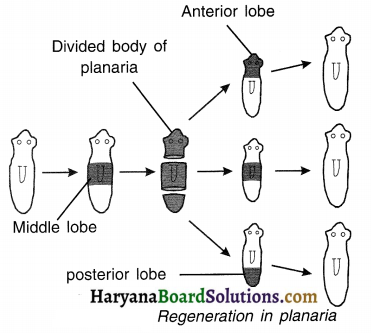
2. If such individuals somehow get cut or broken up into many pieces, many of these pieces grow into separate individuals.
3. For example, simple animals like hydra and planaria can be cut into any number of pieces and each piece would grow into a complete organism.
4. Regeneration is carried out by specialized cells. These cells perform repeated cell division and form large numbers of cells or say cell-mass. From this mass of cells, different cells undergo changes to become various cell types and tissues.
5. These changes take place in an organized sequence which is referred as ‘development’.
6. Note that regeneration is not the same as reproduction because getting cut to reproduce is not the way to reproduce for most of the organisms.
Question 17.
Name the process by which planaria grows. Explain the basic features of this process.
Answer:
Planaria grows through regeneration.
Basic features:
- Regeneration is carried out by specialized cells. These cells perform repeated cell division and form large numbers of cells or say cell-mass.
- From this mass of cells, different cells undergo changes to become various cell types and tissues.
Question 18.
What is budding? Explain.
Answer:
1. In budding, a small part of the body of the parent organism grows out as a ‘bud’. It then detaches from parent and becomes a new organism. For example, hydra and planaria reproduce through budding.

2. During budding, hydra makes use of regenerative cells for reproduction.
3. A bud develops as an outgrowth due to repeated cell division at one specific site. These buds develop into tiny individuals and when they mature fully, they get detached from the parent body and become new independent individuals.
Question 19.
Differentiate between fragmentation and budding.
Answer:
| Fragmentation | Budding |
| 1. Here, the body of a multicellular organism breaks into two or many pieces. 2. Since the body breaks into small pieces, the method is called fragmentation. 3. Spirogyra reproduces through fragmentation. |
1. Here, a bud is formed from the body of the organism which then detaches from the organism. 2. Since only a part of the plant swells and emerges as a bud, it is called budding. 3. Hydra and planaria reproduce through budding. |
![]()
Question 20.
Explain vegetative propagation. OR What is vegetative propagation? Draw a labeled diagram to show vegetative propagation.
Answer:
1. Vegetative propagation is an asexual method of reproduction which occurs only in plants.
2. In vegetative propagation, new plants are reproduced from the plant parts such as roots, stem and leaves of old plants, without taking help of any reproductive organs.
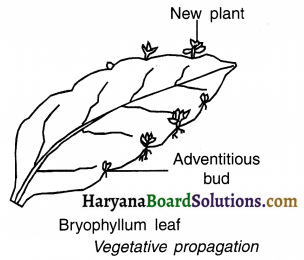
3. There are many plants in which parts such as root, stem and leaves develop into new plants under appropriate conditions.
4. Similarly, buds produced in the notches along the leaf margin of bryophyllum fall on the soil and develop into new plants is also an example of vegetative propagation.
5. This property of vegetative propagation is used in methods such as layering or grafting for growing plants such as sugarcane, roses and grapes.
Question 21.
State the advantages of vegetative propagation.
Answer:
Advantages of vegetative propagation:
1. Plants raised by vegetative propagation can bear flowers and gifts earlier than those produced from seeds.
2. Vegetative propagation is also helpful in growing plants such as banana, orange, rose and jasmine that have lost the capacity to produce seeds.
3. The plants produced are genetically similar to the parent plant and so have similar characteristics as the parent plant.
![]()
Question 22.
Name the plant that reproduces through leaves. List two advantages of this method of reproduction.
Answer:
Bryophyllum is a plant that reproduces through leaves.
Advantages:
- Many buds are produced in the notches along the margin of a single leaf. Each leaf bud of bryophyllum can produce a plant.
- One single leaf reproduces a large number of young plants. This helps in survival of the species.
Question 23.
What is a spore? Explain asexual reproduction through spore formation. OR Explain asexual reproduction in rhizopus.
Answer:
1. A spore is a microscopic reproductive unit of plants which is covered by a protective coat.
2. When the coat of spore bursts, the spores spread into air. These airborne spores settle on food and under favourable condition, germinate to produce new plants.
Example:
1. A bread mould such as rhizopus is a simple multi-cellular organism (fungi). Numerous spores are produced in rhizopus within sacs called sporangia (singular: sporangium).
2. The sporangia are knob (or blob) like tiny structures present at the top of the thread like structures called hyphae. The sporangia contain cells or spores.
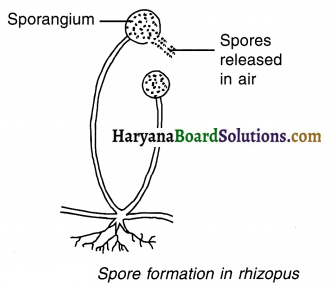
3. When these sporangia bursts, the spores get scattered by rain, wind or insects and under suitable conditions develop into a new rhizopus plant, when they come in contact with a moist substance such as bread.
Question 24.
What is sexual reproduction? Explain very briefly how it takes place.
Answer:
Sexual reproduction :
1. The mode of reproduction that takes place with the help of both male sex cells and female sex cells is known as sexual reproduction.
2. The sex cells involved in sexual reproduction are called gametes.
3. During sexual reproduction, a male gamete unites with a female gamete to produce a ‘zygote’.
4. As time passes, the zygote develops into a new organism.
![]()
Question 25.
Discuss the important aspects of variation occurring during DNA copying.
Answer:
1. Creation of two new cells from one cell involves copying of the DNA’ as well as copying the ‘cellular apparatus’.
2. Although, the two cells will be similar but will not be exactly identical. It is quite obvious that copying of DNA will not be 100% accurate and there will be some variations in the copied version. These variations are known as copying errors. These errors or variations lead to variations in population of organisms.
3. The negative effect of variation is that at times, the variation developed in new cells lead to the death of the cells and even organisms. The positive side of variation is that the species develop resistance to adapt to various environments. This enables the population to survive when a change in the environment occurs.
4. Every individual organism cannot be protected by variations, but variations developed in a population due to DNA copying are useful for ensuring the survival of the species. Thus, ideally, variations in the reproduction are helpful for the organisms.
5. It is a known fact that DNA-copying mechanisms are not absolutely accurate. However, these mechanisms are so accurate that they maintain the speed of variation in such a manner that the DNA copies formed adapt to the cellular apparatus and hence do not die.
Question 26.
How is the process of making variants speeded up by sexual mode of reproduction?
Answer:
1. A single cell divides to form two cells and it involves copying of two things,
- DNA and
- Cellular apparatus.
2. Copying of DNA leads to variation. Moreover, the newly formed DNA copy already contains variations accumulated from previous generations.
3. Owing to these two sources of variations, the two different individuals in a population would have quite different patterns of accumulated variations.
4. When variations from two or more individuals combine, it leads to creation of new combinations of variants. Moreover, each combination would be novel, since each would have come from two different individuals.
5. The sexual mode of reproduction incorporates such a process of combining DNA from two different individuals during reproduction.
Question 27.
How in sexually reproducing organisms, the number of chromosomes and the DNA content maintained at a constant level in each generation?
Answer:
1. In humans, both male and female germ-cells have 46 chromosomes each.
2. In sexually reproducing organisms, each new generation is the combination of the DNA copies from its two parents. So, logically, the new generation organism should have double the chromosome (i.e. 46 + 46 = 92) in its body, but it does not work this way.
3. The germ-cells of sexually reproducing organisms undergo meiosis. Meiosis reduces the number of chromosome to half.
4. Under meiosis, when two haploid germ cells from two individuals combine during sexual reproduction they form diploid zygote which makes the number of chromosome and the DNA content same as its previous generation i.e. 46.
![]()
Question 28.
How are the germ cells different in higher or say complex organisms?
Answer:
As the body design becomes more complex i.e. in higher organisms, the germ cells become specialized and show some differences. They are listed below.
| Male gametes | Female gametes |
| These are called sperms. They are smaller and motile i.e. they move. |
These are called egg cells. They are larger and contain nutrients. |
Question 29.
Draw the diagram of a flower and explain its reproductive parts.
Answer:
1. Flowering plants belong to the group of angiosperms. The reproductive parts of angiosperms are located in the flower. So, we can say that flower is the reproductive organ of the plant. The four main reproductive parts of a flower are:
- Stamen,
- Pistil,
- Petal and
- Sepal
2. Stamen and pistil contain germ-cells (gametes).
(i) Unisexual flower: If the flower contains only one part out of stamen or pistil then such a flower is called unisexual. For example, papaya and watermelon.
(ii) Bisexual flower: If the flower contains both stamen as well as pistil the flower is called bisexual. For example. hibiscus and mustard.
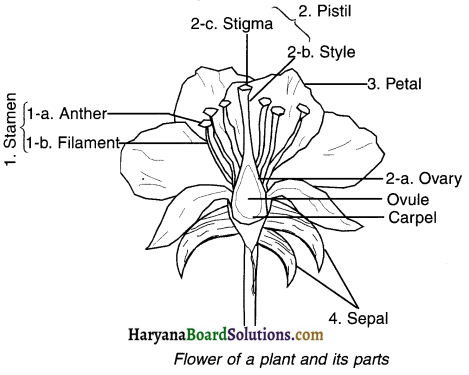
(iii) Male reproductive part: Stamen is the male reproductive part. It produces yellowish coloured pollen grains. Stamen is made up of two parts namely (a) anther and (b) filament.
(iv) Female reproductive part: Pistil (or carpel) is the female reproductive part. It is present at the centre of a flower. It is made of three parts namely, (a) ovary, (b) style and (c) stigma. The swollen bottom part is the ovary, middle elongated part is the style and the terminal part which may be sticky is the stigma. The ovary contains ovules and each ovule contains an egg cell.
![]()
Question 30.
Explain the process of sexual reproduction in flowering plants.
Answer:
Main processes of sexual reproduction:
(a) Pollination:
1. Flowering plants have male and female reproductive parts for conducting sexual reproduction.
2. The ovary (the female reproductive part) contains ovules and each ovule has a female egg-cell. On the other hand, the stamen (the male reproductive part) produces pollen grain which contains male germ-cell.
3. The female and male germ-cells fuse with each other. If the cells fertilize, they produce a zygote. The zygote then grows into a new plant.
4. Thus, for the formation of a zygote and hence a new plant, the pollen needs to travel from the stamen to the stigma. This is called pollination.
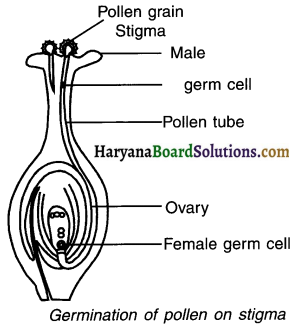
(b) Fertilization:
1. After the pollen grain lands on a suitable stigma, it has to reach the female germ-cells which are in the ovary For this, a tube grows out of the pollen grain and travels through the style to reach the ovary.
2. The process of fusing of male gamete from the pollen grain and the female gamete in the ovary is called fertilization. Fertilization leads to formation of zygote.
(c) Seed germination:
1. After fertilization, the zygote divides several times to form an embryo within the ovule.
2. The ovule develops a tough coat and eventually develops Into a seed. The ovary containing the seed grows rapidly and ripens to form a fruit. By this time, the petals, sepals, stamens, style and stigma may wither and fall-off.
3. The seed contains the future plant or embryo which develops into a seedling under appropriate conditions. This process is known as germination.
Question 31.
What is pollination? State its types and define them.
Answer:
1. For reproduction of a new plant, the pollen grain must travel from stamen (male reproductive part) to stigma (female reproductive part).
2. The travel of the pollen grain from stamen to stigma is called pollination.
There are two types of pollination. They are:
1. Self-pollination: If the transfer of pollen to the stamen occurs in the same flower, it is known as self-pollination.
2. Cross-pollination:
- If the transfer of pollen to the stamen occurs from one flower to another, it is known as cross-pollination.
- The transfer of pollen from one flower to another takes place by agents such as wind, water, insects or animals.
![]()
Question 32.
What do you mean by a unisexual and a bisexual flower?
Answer:
1. Unisexual flower: If the flower contains only one part out of stamen or pistil then such a flower is called unisexual. For example, papaya and watermelon.
2. Bisexual flower: If the flower contains both stamen as well as pistil the flower is called bisexual. For example. hibiscus and mustard.
Question 33.
Give a brief idea about the reproductive organs stamen and carpel (pistil) OR Male reproductive parts and female reproductive parts of a flower.
Answer:
1. Male reproductive part: Stamen is the male reproductive part. It produces yellowish coloured pollen grains. Stamen is made up of two parts namely
- anther and
- filament.
2. Female reproductive part: Pistil (or carpel) is the female reproductive part. It is present at the centre of a flower. It is made of three parts namely,
- ovary,
- style and
- stigma.
The swollen bottom part is the ovary, middle elongated part is the style and the terminal part which may be sticky is the stigma. The ovary contains ovules and each ovule contains an egg cell.
Question 34.
State the functions of petals and sepals.
Answer:
Function of petal:
- Petals are modified leaves that surround the reproductive parts of flowers.
- Generally, petals are of bright colour and hence attract insects for conducting pollination.
Function of sepal:
- Sepals are the lower or outermost part of the flower.
- Their main function is to fold the closed bud and protect it from cold and other environmental effects.
![]()
Question 35.
Give a brief idea about changes that a human body experiences in early childhood.
Answer:
(a) Changes in infancy:
- Our body changes drastically between the period of infancy and childhood. Several changes occur in this period.
- Our height and weight increase as we grow.
- First, we acquire milk teeth then we lose them and acquire permanent teeth.
- All these changes can be grouped under the general process of growth,which the body becomes larger.
(b) Changes in the early teenage: In early teenage years, a whole new set of changes occur which are not just restricted to enlargement of body.
(i) Changes common to boys and girls include —
- The changes in the early teenage are changes in the appearance of a human, changes in the body proportions, attaining new features, sensations, etc.
- Thick and dark hair start growing in armpits and the genital area between the thighs.
- Thin hair appear on legs, arms and even face.
- The skin becomes oily and sometimes pimples begin to develop.
- We start becoming conscious and aware of our own bodies as well as bodies of others in new ways.
(ii) Other changes (Secondary sexual changes):
(a) In girls:
- The breasts start increasing. The nipples become dark.
- The ovary starts secreting female sex hormones. Hence, girls begin to menstruate at around this time.
(b) In boys:
- The testes start secreting male sex hormones.
- The penis occasionally becomes enlarged and erect, either in daydreams or at night.
- The facial hair becomes thick and the soft voice starts becoming cracked and later, deep.
- The body becomes more muscular and shoulder and chest become broad.
![]()
Question 36.
Which uncommon (secondary sexual) changes do boys and girls experience during puberty?
Answer:
Other changes (Secondary sexual changes):
(a) In girls:
- The breasts start increasing. The nipples become dark.
- The ovary starts secreting female sex hormones. Hence, girls begin to menstruate at around this time.
(b) In boys:
- The testes start secreting male sex hormones.
- The penis occasionally becomes enlarged and erect, either in daydreams or at night.
- The facial hair becomes thick and the soft voice starts becoming cracked and later, deep.
- The body becomes more muscular and shoulder and chest become broad.
Question 37.
Discuss some important features of changes that human body experiences.
Answer:
1. The changes that occur in humans from infancy to childhood, to teenage and finally to fully grown matured body takes place quite slowly over several years. Moreover, neither do all these changes happen together at the same time in one person, nor do they happen at an exact age.
2. In some people, the changes happen early and quickly, while in others, they can happen slowly.
3. Each change takes its own time to get completed. For example, when thick hair starts growing on a boy’s face, they do not grow all of a sudden and in perfect manner on entire face. Initially, the hair grows in a scattered manner and gradually it becomes uniform and complete.
4. The changes are not uniform in all humans. For example, one may have a thick, full grown beard while another may have very less growth of facial hair. Similarly, different people will have different shaped noses or fingers. patterns of hair growth, or size and shape of breast or penis, etc. All of these changes signify that the body is becoming matured with time.
![]()
Question 38.
Why does the body show sexual maturation during teenage?
Answer:
1. The bodies of multi-cellular organisms need special kind of cells to carry out specialized functions. Producing germ-cells so that they can participate in sexual reproduction is one such specialized function. Both plants and animals develop special tissues for this function.
2. The growth of the body and maturation of the reproductive tissues happen in a contrasting manner. The reproductive tissues do not mature during the growth stage of the body. The tissues begin to mature when the general body growth begins to slow clown. The stage when the reproductive tissues start to mature is known as puberty.
Question 39.
What is the pre-requisite for sexual reproduction In humans?
Answer:
1. The bodies of individuals must have matured to the stage of reproduction.
2. The reproductive organs must have developed to a stage where they can undergo sexual reproduction.
For example, in men penis is a special reproductive organ. It should be able to become erect to participate in the process of reproduction.
3. In mammals such as humans, the baby is carried in the mother’s body for a long period, and will be breast-fed later. The female reproductive organs and breasts will need to mature to accommodate these possibilities.
4. Just like humans, animals must also be able to identify that they are sexually matured to undergo mating. For sexual mode or reproduction, the germ-celLs of male and female should join with each other. This can happen in two ways. They are:
(a) When individuals (plants and humans) release the germ-cells Out of their bodies.
(b) When two individuals (animals) join their bodies together internal transfer of germ-cels for fuaion.
Question 40.
What is puberty ? Explain what happens when a boy or a girl attains it.
Answer:
1. The age at which a body starts producing gametes and girls and boys become biologically capable to reproduce is known as puberty.
2. Generally, girls attain puberty at the age of 12 years, while-boys reach puberty at the age of 13 to 14 years.
3. On attaining puberty, testes start producing sperm and ovaries start producing eggs.
4. The sex hormones start getting secreted.
5. The time between childhood and adulthood is known as ‘adolescence’.
6. Many changes take place during puberty, such as new hair growth, body becomes more muscular, voice deepens, shoulders and chest broadens, etc.
7. The penis becomes larger and capable of becoming erect.
8. In humans, the baby is carried in mother’s body for a long period and will be breast fed after birth.
9. The female breast and reproductive organs develop to accommodate these possibilities.
![]()
Question 41.
Why does the body of human beings mature sexually?
Answer:
1. Every organism participates in reproduction. In order to reproduce, the organism must produce sex cells in its body.
2. Reproduction requires certain specialized cells which the body starts producing during the time of puberty.
3. So, for reproduction which is carried out by specialized cells, human beings mature sexually.
Question 42.
Draw a labelled diagram of human male reproductive system and explain it.
Answer:
The male reproductive system: The human male reproductive system consists of parts which produce male gametes and parts that transfer the gametes to the site of fertilization.
Main reproductive organ:
Testes:
- Testes are paired, oval shaped glands which produce the male gametes and secrete sex hormones, testosterone.
- The testes lie in muscular pouch called scrotum present outside the abdominal cavity.
- The temperature of testes remains 230 C below the body temperature. This is essential for the formation of sperms.
- Testes secrete the male sexual hormone called testosterone.
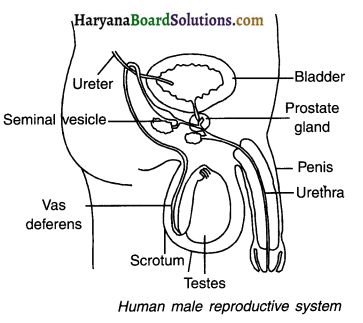
Path of motion of sperm:
Vas deferens:
- The sperms formed are released into a long tube called vas deferens where they remain stored until they are released from the body.
- When the sperm is moving through the vas deterens, glands like the prostate and the semin vesicles add their secretions to the sperm and make it fluid. Fluid form makes the transport C sperm easier. Moreover, the fluid also provides nutrition.
- The was deferens joins with urinary duct which comes out from urinary bladder.
- Now, it is known as urethra.
![]()
Urethra:
Urethra transfers the sperms to an organ called penis. in males, both sperm as well as urine pass through urethra.
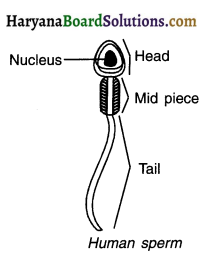
Penis:
- The penis opens up outside the body through a hole-like structure.
- The sperms may be either released outside the body through this pore or may be released into the vagina of a woman’s body during mating.
- Sperms are tiny bodies that mainly consist of genetic material. They have a long tail that helps them to move towards the female germ-cell.
Question 43.
Draw a labeled diagram of female reproductive system and explain how the system works.
Answer:
1. A pair of ovaries, oviduct, fallopian tube, uterus and vagina are the main parts of a female reproductive system.
2. The female reproductive system is more complicated than male because it takes care of fertilization and the development of embryo till the birth.
(i) Ovaries:
- Two oval shaped ovaries lie inside the abdominal cavity.
- The function of ovaries is to produce female sex cells called ova or eggs.
- The ovaries also secrete female sex hormones called estrogen and progesterone.
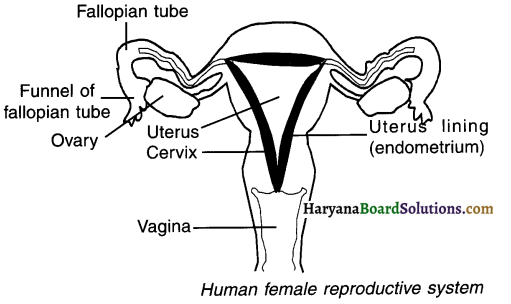
(ii) Fallopian tubes (oviducts): Fallopian tubes are a pair of tubes.
- The funnel-shaped open end of the tubes lies just above the ovaries. This end of the tube receives ova (female egg cells) from the ovary. Then the tube carries it to the uterus.
- The upper part of fallopian-tube also does the work of fertilizing the ova in case it receives sperm cells.
![]()
(iii) Uterus:
The two fallopian tubes unite to form a thick walled muscular bag like structure called uterus.
(iii) Uterus:
- The two fallopian tubes unite to form a thick walled muscular bag-like structure called uterus.
- Uterus looks like an inverted triangle. It receives ovum from oviduct.
- Fertilized ovum develops and grows in the uterus.
(iv) Cervix:
The lower one-third part of uterus is called cervix.
(v) Vagina:
- Uterus opens into tubular structure called vagina.
- Vagina receives sperms through penis.
Question 44.
Explain the stages from release of ovum to embryo till child birth in females. OR Explain implantation and child birth in females.
Answer:
When a girl is born, the ovaries already contain thousands of immature eggs. When she reaches the age of about 10-12 years i.e. when she attains puberty, the sex hormones cause the ova (sex cells or germ cells) to become mature.
Ovulation:
- Every month one of the ovaries produces one ovum.
- After the ovum becomes matured, it is released from the ovary into the oviduct (fallopian tube). This is known as ovulation.
Fertilization:
- Before ovulation, the inner wall of uterus becomes thick and its blood capillaries become full of blood.
- During sexual intercourse the man ejaculates (releases) the sperms in the vagina.
- The sperms then travel upwards into the fallopian tube. If it finds a matured ovum it unites with
it in the upper part of the tube and fertilizes it. Here, we say fertilization has taken place. The fertilized ovum is known as zygote.
Embryo formation:
1. The fertilized ovum gets implanted on the lining of the uterus, starts dividing and forms a hollow ball of cells called embryo.
2. The embryo gets nutrition from mother’s blood through a disc-like special tissue called placenta.
3. The exchange of oxygen, nutrients and waste products takes place through the placenta.
4. The embryo continues to develop in the uterus for nine months.
5. As the foetus grows, the muscles of uterus keep expanding to accommodate the foetus.
6. Finally, the child comes out of the female body (i.e. is born) due to the rhythmic contraction of the uterus muscles.
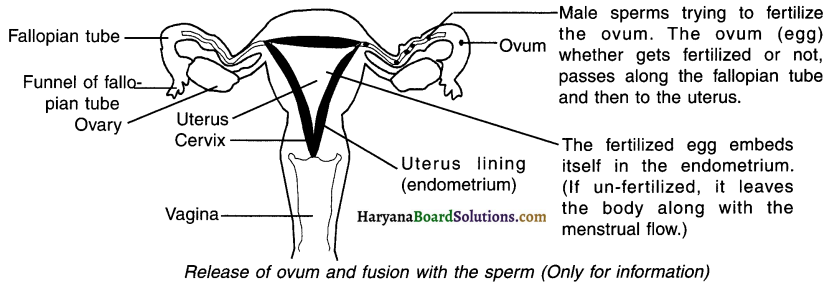
Question 45.
Write a note on placenta.
Answer:
1. Placenta is a temporary organ which is made up of disc-shaped special tissue. It develops in the uterus when the female becomes pregnant.
2. One side of the placenta has villi. This side faces the mother’s body.
3. On the mother’s side are blood spaces, which surround the villi. This provides a large surface area for glucose and oxygen to pass from the mother to the embryo.
4. The other side of the placenta has an umbilical cord which connects to the foetus.
5. The waste generated by the foetus is removed by transferring it into the mother’s blood through the placenta.
![]()
Question 46.
Explain menstrual cycle in females.
Answer:
Menstrual cycle In females:
1. When a girl reaches the age of about 10-12 years i.e. when she attains puberty, the sex hormones cause the ova (sex cells) to become mature.
2. Every month one of the ovaries produce one ovum.
3. After the ovum becomes matured, it is released from the ovary into the oviduct (fallopian tube). This is known as ovulation.
4. Before ovulation, the inner wall of uterus becomes thick and its blood capillaries full of blood.
5. At this stage, utews prepares itself to receive a fertilized ovum.
6. The thick lining makes itself ready for implantation of embryo.
7. In the ovum does not receive a sperm, it will not get fertilized and hence no embryo will develop in the uterus. Such an egg will live for one day.
8. Now, the thick wall (lining) of uterus along with the blood vessels and dead ovum will come out of the vagina in the form of blood and mucous. This is known as menstruation.
9. Menstruation lasts for about 2-8 days. Since the ovary releases one egg every month, the uterus also prepares itself every month to receive a fertilized egg. When menstruation is over, the inner wall of uterus starts building up again so that it may receive the next fertilized ovum.
10. Again if the ovum does not get fertilized, menstruation will occur after 28 days.
11. The process of menstruation stops when a woman gets pregnant i.e. when the ovum gets fertilized.
12. Once the pregnant woman delivers the baby, the menstruation restarts, after some months.
Question 47.
“If a boy or a girl has started becoming sexually mature, he/she can participate In sexual acts and give birth to children.” Do you agree with this statement? Explain your view.
Answer:
1. The process of sexual maturation is gradual and it occurs while general body growth is still going on. During such a period some may think that the body and the mind is ready for sexual act and giving birth to a child, but it is not so. During such a time there are many different kinds of pressures about these issues.
2. There can be pressure from our friends for participating in many activities, whether we really want to or not. There can be pressure from families to get married and start having children.
3. There can be pressure from government agencies to avoid having children.
4. Under such situation, one cannot decide what is wrong and what is right.
5. Hence, some degree of sexual maturation does not necessarily mean that the body or the mind is ready for sexual acts or for having and bringing up children.
Question 48.
What are sexually transmitted diseases? Name a few of them. Also name the responsible vectors.
Answer:
Sexually transmitted diseases:
- The infectious diseases which are spread from an infected person to a healthy person through sexual contact are called sexually transmitted diseases (STDs).
- These disease can be caused either by bacteria or by virus.
- Syphilis and gonorrhoea are bacterial diseases whereas AIDS and warts are viral disease.
- AIDS is caused by a virus called Human Immuno Deficiency Virus (HIV).
![]()
Question 49.
What is contraception? List out the methods of contraception and explain them.
Answer:
Contraception :
The method to prevent pregnancy in women is called contraception. Methods adopted to prevent pregnancy are called contraceptive methods.
Methods:
(1) Birth control tools:
- Under this method, a mechanical barrier is created which prevents the entry of sperm into the genital tract. As a result, fertilization does not occur.
- The tools include condoms to be worn on penis andlor diaphagm worn in the vagina by female.
- Another tool s placing Intra-Uterine Contraceptive Devices (IUCDs) like Copper-T into the uterus of females to prevent pregnancy.
(2) Birth control pills:
There are oral pills that a women can take. These pills change the hormonal balance of the body so that the eggs are not released by the ovaries and fertilization is prevented.
(3) Surgical methods:
- In males, a small portion of vas deterens is surgically removed or tied.
- This process is known as vasectomy and it prevents the sperms from entering urethra. (Note: ectomy means to remove by surgery)
- In females, the fallopian tube is surgically cut and tied. This process is known as tubectomy. It will not allow the sperm to reach the uterus.
(4) Abortion:
Another method is to surgically remove the foetus from the body of pregnant women. However, this is not a method to prevent pregnancy but to prevent child-birth after pregnancy.
![]()
Question 50.
State the disadvantages of contraception.
Answer:
Disadvantages of contraception:
- Oral pills change hormonal balance of a woman’s body and hence cause several side-effects.
- Copper-T causes Irritation in the uterus and hence leads to side effects.
- If the surgery to block a portion of vas deferens or fallopian tube is not done properly it may cause infections.
Question 51.
Why contraceptive methods play an Important role In avoiding unwanted pregnancy?
Answer:
1. Sexual act may lead to pregnancy. Pregnancy will put a lot of biological, physical and mental stress on woman, If the woman is not ready to handle it. her health will be adversely affected.
2. So, there are several ways devised to avoid pregnancy until both man and woman are ready to handle the situation and responsibility to give birth to a child. This gives rise to the need of adopting contraceptive methods to avoid pregnancy.
Question 52.
List any two reasons why the government has banned prenatal sex determination by law.
Answer:
(i) To stop people from forcefully aborting female foetus.
(ii) To maintain the female-male sex ratio in the society.
![]()
Question 53.
“Cell division is a type of reproduction in unicellular organisms.” Justify.
Answer:
1. Unicellular organisms such as bacteria simply split into two equal halves during cell division to produce two new individuals. For example, plasmodium which is a unicellular organism divides into many daughter cells and each cell turns out to be an individual.
2. Thus we can say that in unicellular organism, cell division is a type of reproduction.
2. “Multicellular organisms cannot divide cell by cell”. List two reasons to justify this statement.
- Multicellular organisms have complex bodies.
- Their bodies consist of set specialized cells for carrying out specifIc functions. The cells then get organized as tissues and tissues as organs which then together form the entire body. Each organ performs a specific function.
- Owing to such complex structure of multicellular organisms, cell by cell division for reproduction is flot possible.
3. Colonies of yeast fail to multiply in water, but multiply in sugar solution. Give reason.
- All living organisms need energy to perform activities like respiration, movement, reproduction, etc.
- Yeast Is also a living organism and so it also requires energy to reproduce i.e. multiply.
- Yeast does not receive any nutrition in water arid so the colony of yeast does not multiply in water.
- Sugar solution provides nutrition to the yeast which in turn gives it energy. Hence, the colonies of yeast multiply in the sugar solution.
4. Why does bread mould grow profusely on a moist slice of bread rather than on a dry slice of bread?
- Moist environment of bread slice offers moisture as well as nutrients to the bread mould. Moisture is one of the basic requirements for mould to grow and hence it grows profusely.
- Dry slice of bread offers nutrients but not moisture. Hence,mould does not grow on dry bread.
5. Why fertilization cannot take place In flowers If pollination does not occur?
- During pollination, the pollen grains i.e. the male gametes enter the stigma i.e. the female reproductive organ with an objective of fusing with the female gamete.
- Naturally, if pollination does not occur, the female and male gametes cannot unite and fertilization cannot occur.
6. Contraceptive pills helps in stopping pregnancy. Give reason.
- The oral contraceptive pills contain a combination of hormones which stop the production of ova. This prevents fertilization.
- Similarly, the vaginal pills contain chemical known as spermicide which kills sperms.
- In any case, the fertilization of ovum is prevented.
- Thus, contraceptive pills help in stopping pregnancies.
![]()
Question 54.
What is female foeticide? Explain.
Answer:
Female foeticide:
1. The killing of unborn girl child is known as female foeticide.
2. Some people are not interested to have a girl child and are only interested in a boy.
3. In order to find out whether the foetus in the pregnant lady is male or female, people illegally make use of an ultrasound technique called sonography. This process is called sex-determination.
4. If the foetus is that of female, people get it removed by surgery or medications.
5. Government has put a strict ban on such sonographies and female foeticide. In fact these acts are now criminal acts.
6. By female foeticide, child sex ratio is reducing at an alarming rate in the society.
Question 55.
Differentiate between asexual and sexual reproduction.
Answer:
| Asexual reproduction | Sexual reproduction |
| The reproduction of a new organism from single parent is known as asexual reproduction. | The reproduction of a new organism, from two parents of opposite sex is known as sexual reproduction. |
| No sex cells (gametes) are involved while reproduction. | Sex cells (gametes) are involved while reproduction. |
| In asexual reproduction, certain body parts of the parent separate off and form new organisms of same kind. | In sexual reproduction, the reproductive organs of both the sex develop, produce gametes and after copulation, conducts fertilization. The fertilized egg develops in the same organism. |
| Fission, regeneration, budding, etc are the examples of asexual reproduction. | The waste generated by the foetus is removed by transferring it into the mother’s blood through the placenta. |
Question 56.
List any two differences between pollination and fertilization.
Answer:
| Pollination | Fertilization |
| The transfer of pollen grains from the anther to the stigma of a flower as called pollination. | Fertilization is the fusion of male germ-cell with female germ cell in the ovule. |
| Pollination takes place with the help of an agent such as wind or insect. | Fertilization takes place with the development of pollen tube which carries male gamete to the female gamete in the ovule. |
| Pollination leads to fertilization and hence formation of embryo. | Fertilization leads to the formation of zygote. |
![]()
Question 57.
Differentiate between puberty in males and puberty in females.
Answer:
| Puberty in males | Puberty in females |
| 1. Boys attain puberty at the age of 13-14 years 2. Testes of boys start producing sperms. 3. Voice of boys become deep. 4. Pene becomes larger and capable of getting erect. 5. Muscles of boys become strong and broad. |
Girls attain puberty at the age 10-12 years. Ovaries of girls start producing ovum. Voice of girls become shrill. Breasts and reproductive organs develop. Muscles of girls remain soft. |
Question 58.
Distinguish between the functions of ovary and testes.
Answer:
| Ovary | Testes |
| 1. Ovary produces female germ-cells/ova. 2. Ovaries are located inside the female body in a pelvic cavity. 3. Ovary secrete female hormone oestrogen. |
Testes produces male germ-cells or sperms. Testes are situated outside the body in a pouch like structure called scrotum, Testes produces male hormone called testosterone. |
Question 59.
Differentiate between male reproductive system and female reproductive system.
| Male reproductive system | Female reproductive system |
| 1. It consists of testes, scrotum, epididymis, vas deferens. seminal vesicle, prostate gland and penis. 2. Testes, the organs that produce sex cells, lie outside the abdominal cavity in the muscular pouch. |
1. It contains of ovaries, fallopian tubes, uterus and vagina. 2. Ovaries, the organs that produce sex cells,lie inside the abdominal cavity. |
Question 60.
Differentiate between vasectomy and tubectomy.
| Vasectomy | Tubectomy |
| 1. In this method, a small portion of male vas deferens is surgically removed and both cut ends are tied properly. 2. This method prevents the sperms from entering the urethra. |
In females a small portion of oviduct is surgically removed and tied up from the tips. This method prevents ovum from entering oviduct. |
![]()
Question 61.
Identify A, B and C in the given diagram and write their functions.
Answer:
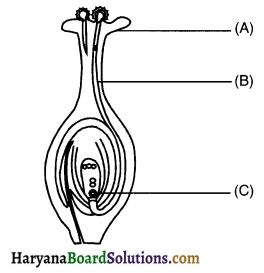
Part-A: It is stigma. Pollen lands on stigma. The stigma then provides proper conditions for the germination of pollen and develops pollen tube for transferring the pollen further.
Part-B : It is pollen tube. It grows from the pollen grain and travels through style. It carries the male germ cell to the ovary for fertilization.
Part-C: It is female germ cell in the ovary, It unites with the male germ-cell to carry out fertilization.
Question 62.
Name those parts of a flower which serve the same function as the following do in animals:
(i) Testes, (ii) Ovary, (iii) Eggs, (iii) Sperms
Answer:
|
Part of animal |
Part of plant which performs the same function |
| Testes Ovary Eggs Sperm |
Anther |
Question 63.
Would a planaria cut vertically into two halves into two individuals? Complete the given figure D and E by indicating the regenerated regions.
Answer:
Planaria has a very good capability to regenerate. Hence, even if we cut its body into two vertical halves, each piece of the body of planaria will grow into two complete individuals.

Question 64.
Trace the path of sperm during ejaculation and mentIon the gland and their functions associated with the male reproductive system.
Path of sperm during ejaculation:
Testes → Epididymis → Vas deferens → Urethra → Penis → Released outside the body
Answer:
Glands associated with male reproductive system and their functions:
(a) Testes: Secretes the hormone testosterone and spermatogenesis
(b) Prostate gland: Makes the semen medium alkaline
(c) Seminal vesicle: Adds fluid content to semen
![]()
Question 65.
In the given figure, label the parts and mention their functions.
(a) Production of egg (b) Site of fertilization (c) Site of implantation (d) Entry of the sperms
(Note: We have directly given the image and marked the asked parts. Students will be given a blank diagram.)
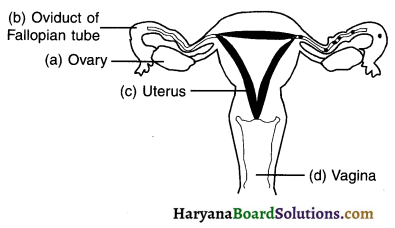
Answer:
|
Part |
Function |
|
(a) Ovary |
Produces eggs Site of fertilization Site for implantation Sperms enters from here into the female body |
Very Short Answer Type Questions
Question 1.
How can we identify if two distinct organisms belong to same species?
Answer:
Two distinct organisms would have resembling physical traits of a particular species. These traits helps in identifying if two organisms are from the same species or not.
Question 2.
Why would you say that a parent and a child are similar but not completely identical?
Answer:
Although in reproduction, DNA copying takes place but this biochemical reaction is not an exact copy. Some minor variations take place each time DNA is copied. Hence it can be said that a parent and a child are similar but not completely identical.
Question 3.
What happens if protein synthesis of DNA changes?
Answer:
It will change the body design of the organism.
![]()
Question 4.
How does DNA copying leads to variation?
Answer:
During cell division, a cell divides to give rise to two cells. Although, the two cells will be similar but will not be exactly identical. It is quite obvious that the process of copying the DNA will have some variations. Hence, DNA copies generated will be similar, but may not be identical to the original and show some variation.
Question 5.
What is the full form of DNA?
Answer:
Deoxyribonucleic Acid
Question 6.
How are the newly formed cells with respect to their parent cells?
Answer:
The cells that survive after the cell division are
1. similar to each other as well as
2. different i.e. show variation.
Question 7.
Which two main aspects are Involved during creation of two new cells from one cell?
Answer:
It involves
1. Copying of the DNA and
2. Copying the cellular apparatus.
Question 8.
When does the newly formed copies of DNA separate?
Answer:
Newly formed copies of DNA separate when the additional cellular apparatus is formed at the time of cell division.
Question 9.
What is coying error?
Answer:
When a new cell is formed from existing cells, the new cell will be similar but will not be exactly identical. The copying of DNA will not be 100% accurate and there will be some variations in the copied version. These variations are known as copying errors.
![]()
Question 10.
State one positive and one negative effect of copying error or say variation.
Answer:
The negative effect of variation is that at times, the variation developed in new cells lead to the death of the cells and even organisms. The positive side of variation is that the species develop resistance to adapt to various environments. This increases the chances of survival.
Question 11.
What is a clone?
Answer:
A clone is an identical genetic copy of a piece of DNA, or a cell or a whole organism. Many organisms produce clones through asexual reproduction.
Question 12.
What is a niche? Give one example.
Answer:
A niche is the role and position a species plays in the environment, how the species meets its needs for food and shelter, how it survives and how it reproduces.
For example, a lion gathers its food, shelter or reproduces in a specific way which is quite different from that of a crocodile.
Question 13.
State any two climatic factors which can affect and change the niche of a species.
Answer:
Drastic change in temperature and differing water levels are two of the many climatic factors which can have an effect on niche.
Question 14.
How can we classify the types of reproduction based on the number of parent organism involved in it?
Answer:
Reproduction can be classified into two types as
(i) Asexual reproduction and
(ii) Sexual reproduction
![]()
Question 15.
Mention any four types of asexual reproduction.
Answer:
(i) Fission
(ii) Budding
(iii) Regeneration
(iv) Vegetative propagation
Question 16.
Look at the diagrams provided here and identify the type of asexual reproduction show in them.

(i) Fission,
(ii) Budding
Question 17.
State the types of fission. Explain them briefly and give one example of each.
Answer:
Types: Binary fission and multiple fission
(i) In binary fission, a cell splits into two halves to form two individual cells.
Example: Amoeba.
(ii) In multiple fission, the parent cell divides into multiple daughter cells simultaneously.
Example: Plasmodium.
Question 18.
Give examples of two organisms which are capable of regeneration.
Answer:
Planaria and hydra are capable of regeneration.
Question 19.
How does rhizopus reproduce? Is this method sexual/asexual?
Answer:
Rhizopus reproduces through spore formation. This method is asexual.
Question 20.
Give examples of animals that reproduce
(i) sexually and
(ii) asexually. (Give two examples of each).
Answer:
(i) Dogs and humans reproduce sexually.
(ii) Hydra and amoeba reproduce asexually.
![]()
Question 21.
Which method is used for growing sugarcane? Give two other examples of plants which can be grown through same method.
Answer:
Sugarcane Is grown through grafting which is a type of vegetative propagation. Roses and grapes can also be grown through grafting.
Question 22.
Choose the odd one out from the following. Justify your answer.
Answer:
Bryophyllum, Hibiscus, Spirogyra. Hydra, Planaria.
Odd one: Hibiscus Reason: Except hibiscus, all the organisms mentioned reproduce asexually.
Question 23.
Can a dog reproduce through regeneration? Justify your answer.
Answer:
A dog has a very complex multicellular body formation and hence each organ is formed with specialized cells which are meant for specific function. In this case, one type of cell cannot reproduce to form entire body of a dog. Hence ………………
Question 24.
Why do we notice minute variations among two organisms of the same population?
Answer:
The DNA copying mechanism although similar is not absolutely accurate. This results in minor variations in DNA copying. Hence, we notice
some dissimilarity between two organisms of same species,
Question 25.
How does a zygote get the energy to develop into tissue and eventually Into organs?
Answer:
The female gamete generally consists of food reserve which can be utilized as energy source when it forms zygote by combining with a male gamete.
![]()
Question 26.
Name the reproductive organs found in a flower. Also classify them as male and female.
Answer:
Stamen and carpel are reproductive organs found in a flower. Stamen is male whereas carpel is a female reproductive organ.
Question 27.
What is a unisexual flower?
Answer:
If the flower contains only one part out of stamen or pistil then such a flower is called unisexual flower.
Question 28.
What is a bisexual flower?
Answer:
If the flower contains both stamen as well as pistil, the flower is called bisexual flower.
Question 29.
Give two examples each of unisexual and bisexual flowering plants.
Answer:
Unisexual: Papaya arid watermelon Bisexual: Hibiscus and mustard
![]()
Question 30.
Differentiate between pollen grain and ovule.
Answer:
Pollen grain, found in stamen consists of male germ-cells whereas ovule, found in the ovary of carpel consists of female germ-cells.
Question 31.
What are the constituents of carpel? Mention in the order of occurrence from bottom to top.
Answer:
Carpel Consists of
- Ovary at the bottom,
- Style in the middle and
- Stigma at the top.
Question 32.
Which are the external agents responsible for cross-pollination of angIosperms?
Answer:
External agents such as wind, water and animals are responsible for cross-pollination.
Question 33.
What happens to the pollen grain after it lands on a stigma?
Answer:
Once a pollen grain lands on a stigma, a pollen tube grows out of the grain to reach the egg cells in ovary through the style.
Question 34.
Which are the three commonly used plant propagation techniques for growing garden plants?
Answer:
The three plant propagation techniques are:
- Grafting,
- Cutting and
- Layering
![]()
Question 35.
What is the difference between germination and fertilization?
Answer:
The process of sprouting of a seed into a seedling and eventually into a plant under suitable conditions is called germination. whereas fusion of male and female germ-cells is called fertilization.
Question 36.
Point out any two signs indicating onset of puberty in girls and boys.
Answer:
1. Frequently developing pimples on face
2. Thick hair starts growing in pubic region
Question 37.
Mention any two signs which indicate the onset of puberty In boys.
Answer:
1. Development of thick facial hair growth
2. Occasional enlargement of penis
Question 38.
Mention any two signs which indicate the onset of puberty In girls.
Answer:
1. Increase in the size of breasts
2. Beginning of menstruation at regular interval of time
Question 39.
Where does the formation of sperm cells take place in male reproductive system?
Answer:
The formation of sperm cells take place in testes.
Question 40.
Name the male and female sex cells produced In human body along with the organs that produce them.
Answer:
1. Testes produces sperms which are male sex cells
2. Ovary produces eggs which are female sex cells
Question 41.
Below mentioned are the parts of male reproductive system. Arrange them in the order from the point where sperm formation takes place to the point where semen is transmitted out of the reproductive system. Urethra, Testes, Seminal vesicle, Vas deference, Prostate gland.
Answer:
Testes, Vas deference, Seminal vesicle, Prostate gland, Urethra.
![]()
Question 42.
Name three major sex hormones which are responsible for reproduction in humans.
Answer:
Testosterone, estrogen and progesterone
Question 43.
What is the function of placenta?
Answer:
Function of placenta is to provide nutrition to the foetus through mother’s blood and to collect the waste generated by foetus and discard it through mother’s blood.
Question 44.
What is the frequency of menstrual cycle and how long does one cycle lasts?
Answer:
The frequency of menstrual cycle is approximately one month and it lasts for 2 to 8 days.
Question 45.
Name any two sexually transmitted bacterial Infections.
Answer:
Gonorrhea and syphilis are sexually transmitted disease caused by bacterial infections.
Question 46.
What is the full form of AIDS? Which organism is responsible for infecting this disease?
Answer:
AIDS stands for Acquired Immuno Deficiency Syndrome. This disease is caused by Human Immunodeficiency Virus.
Question 47.
Why is it recommended to use a condom while engaging in a sexual act?
Answer:
Using a condom can prevent transmission of sexually transmitted disease. Moreover, it can also prevent occurrence of unwanted pregnancy. Hence it is advisable to use a condom while engaging in a sexual act.
Question 48.
What do you mean by abortion?
Answer:
Abortion is a surgical method used to terminate an unwanted pregnancy wherein the embryo/foetus is surgical removed from the uterus.
![]()
Question 49.
Mention any two surgical methods with small description adopted to permanently
prevent pregnancy.
Answer:
1. Vasectomy in which the vas deference in male is blocked for semen to ejaculate and
2. tubectomy in which the fallopian tube in female is blocked to prevent egg from reaching the uterus.
Fill in the Blanks:
1. The most fundamental activity that occurs in reproduction for maintaining the structure of the organism is ………………..
Answer:
DNA copying.
2. The white cotton-like mass that appears on the bread which is kept moist for few days is ………………..
Answer:
Mould (Fungus)
3. Which causes kala-azar reproduces through
Answer:
Leishmania, fission
4. Plasmodium and amoeba reproduce through fission. The only difference is, former reproduces through …………… fission whereas later reproduces through ……………. fission.
Answer:
multiple, binary
![]()
5. ……………. is the simplest method of asexual reproduction in unicellular organisms.
Answer:
Budding
6. Fission is …………….. of types.
Answer:
Two
7. An algae which reproduces by the asexual reproduction method called fragmentation is……………..
Answer:
Spirogyra
8. The cut part of plant stem (having roots is fixed to ground) which is used in the process of grafting is …………………
Answer:
Stock
9. Generally, in sexual reproduction …………….. gamete contains food stores whereas ………….. gamete possesses motility.
Answer:
female, male
10. ………………. is the future shoot where as ……………… is the future root of a germinated seed.
Answer:
Plumule, radicle
11. The ovary in a flower transforms to become a ………… after fertihzing.
Answer:
fruit
12. Anther and filament are the constituents of …………… in a flowering plant.
Answer:
stamen
13. Pollen grain landed on a stigma reaches the egg cell through ………………….
Answer:
pollen tube
14. A single cell produced after the fertilization of male and female gametes is called as …………………..
Answer:
zygote
15. After fertilization, zygote divides multiple times to form alan within an …………………..
Answer:
embryo, ovule
![]()
16. ………………….. hormone is responsible for regulating the formation of sperms.
Answer:
Testosterone
17. After the sperm fertilizes egg to form a zygote. it gets attached to the lining of with the help of a tissue known as …………………..
Answer:
uterus, placenta
18. Menstruation lasts for about …………….. days.
Answer:
2to8
19. …………… should be used during a sexual intercourse to avoid transmission of STDs and to avoid unwanted pregnancy.
Answer:
Condoms
![]()
20. In males, a small portion of ……………. is cut to prevent sperms from entering urethra.
Answer:
Vas deferens
True Or False:
1. Reproduction is as important life process as respiration and excretion for sustaining the life of an individual. — False
2. Although not identical, copied DNA should be similar to the parent cell in order to sustain body design in a species of a particular niche. — True
3. Due to minor variations in a niche gradual extinction of a species is observed. Hence. maintaining a niche is very important for survival of a species over time. — False
4. Copy error is a common event during cell division. — False
5. A single-cell parasite which is responsible for causing malaria reproduces through multiple fission. — True
6. Hydra can propagate and reproduce through regeneration as well as budding. — True
7. Plants are capable of propagating themselves from the parts like roots, stems and leaves due to which a new propagation is also possible for those plants which have lost the capacity to produce seeds. — True
8. Generally, male germ-cells are motile and relatively smaller whereas female germ-cells contain food reserves and hence are relatively larger. — True
![]()
9. Mustard and watermelon are the types of angiosperms which reproduce bisexually. — False
10. Carpel found as a reproductive organ of an angiosperm consists of yellowish coloured pollen grains. — False
11. The tough coat in which embryo is formed eventually gets converted into a seed. — True
12. As the human body is growing to its adulthood, sexual maturity also occurs simultaneously to its growth. — False
13. Male reproductive organ which produces sperm is present in scrotum inside the abdominal cavity. — False
14. The temperature in a small muscular sac consisting testes is relatively lower than that of abdominal cavity. This is ideal for the growth of male gametes. –True
15. Both the ovaries produce eggs every month in a female reproductive system. — False
16. The two female sex hormones are produced Inside the uterine cavity and released in the body. — False
17. The inner lining of vagina prepares itself every month to nourish an embryo attached in its walls. — False
18. Condoms are such type of contraceptive tools which are also capable of preventing transmission of sexually transmitted diseases — True
19. Copper-T is a type of contraceptive device placed in uterus to prevent pregnancy. However, using it may cause minor side-effects. — True
20. Prenatal sex determination is a criminal offence as per indian law. — True
Match the Following
Question 1.
| Organism | Type of reproduction |
| 1. Planaria 2. Bryophyllum 3. Rhizopus 4. Hydra |
a. Spore formation b. Fragmentation c. Vegetative propagation d. Budding e. Fission f. Regeneration |
Answer: (1-f), (2-c), (3-a), (4-d)
![]()
Question 2.
| Birth control metho | Example |
| 1. Barrier method 2. Surgical method |
a. Vasectomy b. Contraception c. Condom |
Answer: (1-c), (2-a)
Question 3.
| Column I | Column II |
| 1. Prostate gland 2. Cervix 3. Oviduct 4. Placenta |
a. A special tissue that develops between embryo and the uterus wall b. Fertilization takes place here c. Mouth of uterus d. Secretory gland in the passage of sperms |
Answer: (1 – d), (2 – c), (3 – b), (4 – a)
![]()
Question 4.
| Column I | Column II |
| 1. Approximate life of an unfertilized egg 2. Girls attain puberty 3. Menstruation in female 4. Development of embryo in uterus of female |
a. At least 9 months b. 10 to 12 years c. 2 to 8 days d. About 1 day |
Answer: (1 – d), (2 – b), (3 – c), (4 – a)